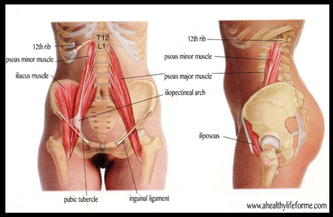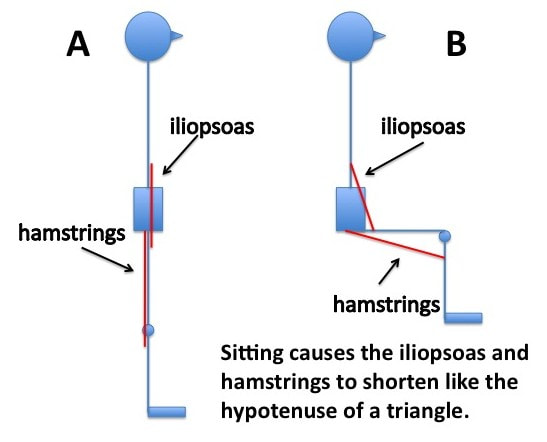
Alignment is about how muscles position bones when moving, sitting, bending, etc.
Misalignment is inefficient posture and movement with the body compensating to stay upright by muscles pulling harder on one side to keep your frame upright. It takes more energy and creates more “friction” like back pain.
Alignment affects circulation to organs and thus their ability to receive nutrients and remove waste and toxicity.
The brain is stressed by the pain signals telling it to do something.
The brain is also stressed even without pain by a lack of circulation that means that tissues are suffocating, starving, or choking on waste.
This is why it is relaxing to receive a massage, stretch, go for a walk, etc: the brain stops being afraid of these problems.
The overall common misalignment pattern is the S curve posture with the hips and head forward, and chest sunken.
The two crucial areas where misalignment begins are the hips and the head, the spine is caught in the middle and can't be stabilized on its own.
Here I focus on hips and the main root cause of misalignment of hips: sitting in chairs.
Sitting in chairs pulls the hips forward by tightening the illiopsoas muscles.
These is hard to visualize but has been called the “core of the abdominal core.”
It attaches on the inside of lower back vertebrae and then down to the inside the thigh bone, femur, on the inside and back side, near the top of the leg.
Sitting in chairs shortens its position as the femur is lifted with knees up and forward creating a shorter distance from the lower back to leg.
This is can be experienced as tightness when you stand up.
The tight pulling also rotates the femur out since its lower attachment is on the inside.
Outward rotation of the femur is most easily seen it outward pointing toes.
S curve posture and outward pointing toes correlate.
So the one practical thing is to point your toes forward while walking and standing. That will start to push hips back to stack the spine.
It’s very simple.
Please NO Questions for further instructions in social media comments, I don’t have time.
Most people will need to do more to loosen hips.
That’s where posture begins, not from “standing up straight” using your lower back to thrust your chest up which throws your hips forward making you lean back..
The other way sitting misaligns the hips is the tailbone area, the sacrum, seems to drop down and out as the back rounds. Some old chairs and tractor seats used to have a butt shape in the seat with a bump of support under the sacrum.area. Nowadays people in pain get special cushions with a space open under the tailbone so there is no pressure to cause pain on a misaligned.
The tailbone is the coccyx, which is below the much bigger sacrum that attaches the back to the wide hip bones. Either one can cause pain when sitting.
I fell on my tailbone as a kid and did not know it until chiropractors and osteopathic doctors examined me. For injuries like that body workers are helpful to get started. Then I needed to learn various forms of self adjustment to finish aligning due to the injury and sitting in chairs. No instructions will be given here.
Misalignments can cause tight muscles and limited movement that restricts circulation of the lymph in the entire area to affect injuries, the urinary tract, reproductive organs, or even the intestines.
Movement of the legs pumps the lymphatic system that flow up past the intestines to the exit up under the collarbone. I notice better bowel movements with walking or other activity.
Problems with the prostate in men and interstitial cystitis bladder problems are often circulation problems stemming from pelvic floor muscles imbalances. This is well known in medical research and there are clinics specializing in this, largely with direct movements to stimulate and stretch those muscles. I prefer to go all the way to the root cause of general misalignment of how you move everything that fails to recruit pelvic floor muscles into their stabilizing roles in compound movements. You can do both isolation and compound movements for best benefit. So learning to walk and sit correctly with support can be helpful.
Misalignment is inefficient posture and movement with the body compensating to stay upright by muscles pulling harder on one side to keep your frame upright. It takes more energy and creates more “friction” like back pain.
Alignment affects circulation to organs and thus their ability to receive nutrients and remove waste and toxicity.
The brain is stressed by the pain signals telling it to do something.
The brain is also stressed even without pain by a lack of circulation that means that tissues are suffocating, starving, or choking on waste.
This is why it is relaxing to receive a massage, stretch, go for a walk, etc: the brain stops being afraid of these problems.
The overall common misalignment pattern is the S curve posture with the hips and head forward, and chest sunken.
The two crucial areas where misalignment begins are the hips and the head, the spine is caught in the middle and can't be stabilized on its own.
Here I focus on hips and the main root cause of misalignment of hips: sitting in chairs.
Sitting in chairs pulls the hips forward by tightening the illiopsoas muscles.
These is hard to visualize but has been called the “core of the abdominal core.”
It attaches on the inside of lower back vertebrae and then down to the inside the thigh bone, femur, on the inside and back side, near the top of the leg.
Sitting in chairs shortens its position as the femur is lifted with knees up and forward creating a shorter distance from the lower back to leg.
This is can be experienced as tightness when you stand up.
The tight pulling also rotates the femur out since its lower attachment is on the inside.
Outward rotation of the femur is most easily seen it outward pointing toes.
S curve posture and outward pointing toes correlate.
So the one practical thing is to point your toes forward while walking and standing. That will start to push hips back to stack the spine.
It’s very simple.
Please NO Questions for further instructions in social media comments, I don’t have time.
Most people will need to do more to loosen hips.
That’s where posture begins, not from “standing up straight” using your lower back to thrust your chest up which throws your hips forward making you lean back..
The other way sitting misaligns the hips is the tailbone area, the sacrum, seems to drop down and out as the back rounds. Some old chairs and tractor seats used to have a butt shape in the seat with a bump of support under the sacrum.area. Nowadays people in pain get special cushions with a space open under the tailbone so there is no pressure to cause pain on a misaligned.
The tailbone is the coccyx, which is below the much bigger sacrum that attaches the back to the wide hip bones. Either one can cause pain when sitting.
I fell on my tailbone as a kid and did not know it until chiropractors and osteopathic doctors examined me. For injuries like that body workers are helpful to get started. Then I needed to learn various forms of self adjustment to finish aligning due to the injury and sitting in chairs. No instructions will be given here.
Misalignments can cause tight muscles and limited movement that restricts circulation of the lymph in the entire area to affect injuries, the urinary tract, reproductive organs, or even the intestines.
Movement of the legs pumps the lymphatic system that flow up past the intestines to the exit up under the collarbone. I notice better bowel movements with walking or other activity.
Problems with the prostate in men and interstitial cystitis bladder problems are often circulation problems stemming from pelvic floor muscles imbalances. This is well known in medical research and there are clinics specializing in this, largely with direct movements to stimulate and stretch those muscles. I prefer to go all the way to the root cause of general misalignment of how you move everything that fails to recruit pelvic floor muscles into their stabilizing roles in compound movements. You can do both isolation and compound movements for best benefit. So learning to walk and sit correctly with support can be helpful.
Primal Rejuvenation Health Coaching
Find out what you get in a
Free Assessment
See how I support you fully in
Health Coaching Steps
I work over video: Facebook, Zoom, Google, from Michigan, USA
[email protected]
Follow me on FACEBOOK:
choose “See First” to get all notifications. blog posts
INSTAGRAM
Primal Rejuvenation
Systematic
enough to make a difference
Simple
enough to implement
Sensitive
to individual needs
*** I do not diagnose or heal medical conditions.
I treat lifestyle and environmental conditions
Medical conditions tend to be symptoms.
Life style and environment tend to be root causes.
When the body has everything it needs it can heal itself. ***
Find out what you get in a
Free Assessment
See how I support you fully in
Health Coaching Steps
I work over video: Facebook, Zoom, Google, from Michigan, USA
[email protected]
Follow me on FACEBOOK:
choose “See First” to get all notifications. blog posts
Primal Rejuvenation
Systematic
enough to make a difference
Simple
enough to implement
Sensitive
to individual needs
*** I do not diagnose or heal medical conditions.
I treat lifestyle and environmental conditions
Medical conditions tend to be symptoms.
Life style and environment tend to be root causes.
When the body has everything it needs it can heal itself. ***

